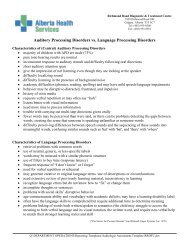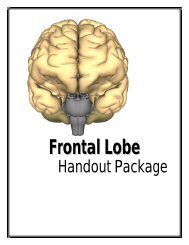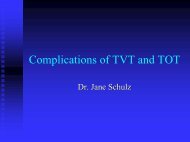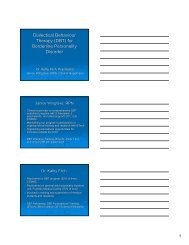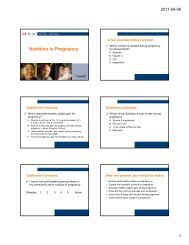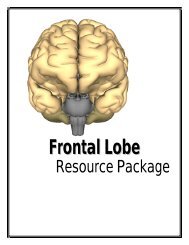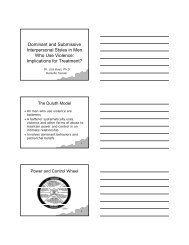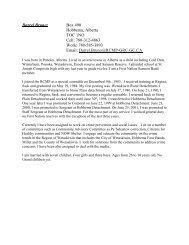Identifying Delirium - Onehealth.ca
Identifying Delirium - Onehealth.ca
Identifying Delirium - Onehealth.ca
You also want an ePaper? Increase the reach of your titles
YUMPU automatically turns print PDFs into web optimized ePapers that Google loves.
<strong>Identifying</strong> <strong>Delirium</strong><br />
Resource Package
Case Study<br />
Margaret is a moderate-to-severely impaired 84-year old widowed woman admitted to<br />
your long-term <strong>ca</strong>re facility. Prior to admission, Margaret had been living with her only<br />
child, a daughter along with the daughter’s husband and teenage son for the past four<br />
years. The decision for placement was difficult.<br />
Margaret has a number of medi<strong>ca</strong>l problems, all of which have been histori<strong>ca</strong>lly well<br />
controlled, including diabetes mellitus, hypertension and osteoarthritis in her hips and<br />
lower back. Margaret has no previous psychiatric history. Margaret has fallen twice<br />
since her recent admission and the slight bruise on her head distresses her family. Over<br />
a short period, the staff has noted changes in the client, which at first were quite subtle<br />
but now are becoming problematic.<br />
Staff observes Margaret picking at things on her clothes and in the air<br />
Margaret’s speech at times is “jumbled”, she <strong>ca</strong>n talk incessantly and be up<br />
throughout the night<br />
Margaret has become increasingly agitated and on one oc<strong>ca</strong>sion has struck another<br />
mobile client<br />
Margaret has become increasingly sensitive to noise and all changes in her<br />
environment, she startles easily<br />
Margaret is easily distracted and has difficulty focusing attention at meal time for<br />
example<br />
Margaret becomes lost easily, unable to find her room<br />
Family have been <strong>ca</strong>lled in on several oc<strong>ca</strong>sions to help deal with Margaret’s<br />
emerging behaviours<br />
Although there is a new staff rotation on the unit, the staff has “heard of” Margaret. It is<br />
Margaret’s day for a shower and the assigned personal <strong>ca</strong>re attendant is not eager to<br />
do it. It is documented over the last few days that Margaret is becoming increasingly<br />
“uncooperative”, “resistive” or “bad” during personal <strong>ca</strong>re. Already, the unit staff is<br />
behind in the day’s schedule and it isn’t even 1000h!
Seniors’ Mental Health Programs Standardized Assessment S<strong>ca</strong>les<br />
ADMINISTRATION AND SCORING GUIDELINES<br />
S<strong>ca</strong>le/Screen:<br />
Use(s):<br />
Time Taken:<br />
The Modified Confusion Assessment Method (CAM)<br />
To facilitate the detection of delirium in patients with dementing<br />
illnesses.<br />
The actual completion of the CAM form takes less than 5 minutes.<br />
The time taken to assess each feature of the CAM depends upon<br />
how familiar the assessor is with the patient being assessed. An<br />
external assessor unfamiliar with the patient would need at least 30<br />
minutes to observe, interview the patient, and check collateral<br />
sources of information before completing the CAM.<br />
It has been noted that assessments completed with multiple<br />
observation points over time showed increased sensitivity and<br />
specificity for the diagnosis of delirium using the CAM format.<br />
Rationale(s):<br />
Commentary:<br />
Many studies have commented on the problems health<br />
professionals have in diagnosing delirium in older adults and the<br />
serious health consequences inherent in delayed treatment.<br />
Patients with a prior dementia are at increased risk for developing<br />
a delirium.<br />
The diagnosis of the delirium in those with dementia is particularly<br />
challenging be<strong>ca</strong>use of the overlap in symptoms in the two<br />
disorders.<br />
The Modified CAM may help clinicians identify possible deliria in<br />
those with prior dementias and facilitate appropriate and early<br />
assessment and treatment interventions.<br />
The original CAM was developed to help detect delirium in acutely ill<br />
elderly hospitalized patients. It was designed for use by nonpsychiatri<strong>ca</strong>lly<br />
trained clinicians to identify delirium quickly and<br />
accurately. The CAM was adopted from DSM III R criteria.<br />
Permission was obtained from Dr. Inouye to modify the format for<br />
patients with dementia. The Modified CAM is more likely to be of<br />
use in the detecting of delirium in those with mild to moderate<br />
dementia, as it has been noted that end-stage dementia may be<br />
indistinguishable from delirium (except by history). The widespread<br />
destruction of brain cells in end-stage dementia may, it is thought,<br />
<strong>ca</strong>use a chronic delirious state.<br />
Enquiries: S.A.S. Committee Chair, c/o AHE Community Geriatric Psychiatry,(780) 424-4660
Seniors’ Mental Health Programs Standardized Assessment S<strong>ca</strong>les<br />
Administration:<br />
The assessor first notes whether or not the patient has a<br />
diagnosed Dementia and of what type and stage.<br />
Acute Onset: Acuity of onset for delirium has been variously<br />
defined from hours to a period usually not exceeding more than<br />
thirty days. Bear in mind that a temporal onset of delirium may<br />
not have been clearly recognized if the onset has been of the<br />
quieter, hypokinetic variety.<br />
Inattention: In early to mid-stage dementia, attentional<br />
processes are usually unimpaired. (See attached table of<br />
differential features of delirium and dementia)<br />
Disorganized thinking: The assessor needs to identify whether<br />
or not there has been a change in the pattern or quality of the<br />
patient’s thinking. Generally, the thoughts of non-demented<br />
delirious patients may be illogi<strong>ca</strong>l, bizarre, disjointed, or<br />
delusional. Their speech may be voluble, excited, or pressured.<br />
Impoverished thought, however, is more often seen in patients<br />
with a dementia and therefore, a delirious and demented patient<br />
may not present as floridly as the non-demented delirious patient.<br />
The sudden appearance of delusional thinking, particularly<br />
suspiciousness, in a previously non-delusional demented patient<br />
may be signifi<strong>ca</strong>nt.<br />
Altered level of consciousness: The patient’s level of alertness<br />
in delirium may be abnormally high or low. The hyper-alert, easily<br />
startled, and fearful patient is more easily identified whereas the<br />
quieter, lethargic, hypo-alert patient may pose a more difficult<br />
problem for the assessor, where the patient’s reduced awareness<br />
may have resulted from other <strong>ca</strong>uses such as over-sedation with<br />
medi<strong>ca</strong>tion. It is important for the assessor to assess if there has<br />
been any fluctuation in the level of alertness over the assessment<br />
period.<br />
Disorientation and memory impairment: These are, of course,<br />
characteristic symptoms of dementia but it should be noted if<br />
there has been an abrupt decline in ability that may be attributed<br />
to a superimposed delirium. In the delirious non-demented<br />
patient, immediate and recent memory are impaired whereas in<br />
the demented, non-delirious patient, immediate memory is usually<br />
intact in the early to middle stages of the disease.<br />
Enquiries: S.A.S. Committee Chair, c/o AHE Community Geriatric Psychiatry,(780) 424-4660
Seniors’ Mental Health Programs Standardized Assessment S<strong>ca</strong>les<br />
Perceptual disturbances: It is important for the assessor to<br />
identify whether or not perceptual disturbances formed part of the<br />
patient’s previous dementia profile (example, Lewy Body<br />
Dementia), or if there has been an acute change in the type of<br />
perceptual disturbance experienced by the patient. Common<br />
perceptual disorders in delirium include micropsia, macropsia,<br />
distortion of shape and body image disturbance as well as<br />
feelings of depersonalization. Illusionary perceptions are<br />
common, for example, family and staff members may be<br />
misidentified; patterns on wallpaper or bed covers may be<br />
misperceived as insects or animals. Illusionary material may be<br />
incorporated into fragmentary delusions which accentuate the<br />
patient’s fear and anxiety.<br />
Psychomotor agitation or retardation: The classic portrayal of<br />
the delirious patient is usually one of hyperkinesis and excitement.<br />
In elderly persons, hypokinesis is more commonly seen. The<br />
hyperkinetic patient is unable to keep still, and repetitive<br />
purposeless behaviour is common. Autonomic signs of hyperarousal<br />
may be evident, for example, sweating, flushed skin,<br />
tachy<strong>ca</strong>rdia and pupillary dilation. The hypokinetic patient, in<br />
contrast, is quieter and may be motionless, often drowsy, his/her<br />
speech may be slow and possibly slurred. A mixed presentation<br />
may be seen with the patient shifting between hyper and hypoactivity.<br />
Altered sleep-wake cycle: An altered sleep-wake cycle may be<br />
seen in dementia where its occurrence is attributed to reduced<br />
acetylcholine activity. It is therefore not a sensitive indi<strong>ca</strong>tor of<br />
delirium, except if it occurs acutely in a patient with a previously<br />
stable cir<strong>ca</strong>dian rhythm.<br />
Scoring:<br />
The assessor first notes, after each of the nine features, whether<br />
there is a change from the patient’s baseline cognitive/behavioural<br />
status. Then, at each of the features, the assessor notes whether the<br />
change is present in mild form or in marked form. Next, the assessor<br />
identifies whether or not features 1, 2 and either 3 or 4 are present in<br />
order for a diagnosis of delirium by CAM to be made, i.e., has the<br />
onset been acute with fluctuating symptoms; is there impaired<br />
“attention”, and are either “disorganized thinking” or an “altered level<br />
of consciousness” present.<br />
Enquiries: S.A.S. Committee Chair, c/o AHE Community Geriatric Psychiatry,(780) 424-4660
Seniors’ Mental Health Programs Standardized Assessment S<strong>ca</strong>les<br />
References:<br />
Inouye, SK, Van Dyck CH, Alessi, CA, , Balkin S, Siegal AP, Horwitz RI.<br />
Clarifying Confusion: The Confusion Assessment Method, Annals of Internal<br />
Medicine. 1990: 941-948.<br />
Rapp CG, Wakefield B, Kundrat M, Mentes J, Tripp-Reimer T, Culp K, Mobily<br />
P, Akins J, Onega L. Acute Confusion Assessment Instruments: Clini<strong>ca</strong>l<br />
Versus Research Usability, Applied Nursing Research, Vol. 13, No. 1<br />
(February), 2000: pp 37-45.<br />
Trzepa<strong>ca</strong> PT, Mulsant BH, Dew MA, Pasternak R, Sweet RA, Zubenko GS. Is<br />
<strong>Delirium</strong> Different When It Occurs in Dementia A Study Using the <strong>Delirium</strong><br />
Rating S<strong>ca</strong>le. The Journal of Neuropsychiatry and Clini<strong>ca</strong>l Neuroscience<br />
1998; 10:199-204.<br />
Zou Y, Cole MG, Primeau FJ, McCusker J, Bellavance F,Laplante J. <strong>Delirium</strong>:<br />
Detection and Diagnosis in the Elderly: Psychiatrist Diagnosis, Confusion<br />
Assessment Method, or Consensus Diagnosis International<br />
Psychogeriatrics, 10(3), September 1998.<br />
Monette J, Galbaud du Fort G, Fung SH, Massoud F, Moride Y, Arsenault L,<br />
Afilalo M. Evaluation of the confusion assessment method (CAM) as a<br />
screening tool for delirium in the emergency room. General Hospital<br />
Psychiatry23 (2001) 20-25.<br />
Culp K, Tripp-Reimer T, Wadle K, Wakefield B, Akins J, Mobily P, Kundradt M.<br />
Screening for Acute Confusion in Elderly Long Term Care Residents. Journal<br />
of Neuroscience Nursing April, 1997 Vol. 29, No.2, 86-94.<br />
January 3, 2003<br />
WP/SMHPCC/Guidelines – Modified CAM<br />
Enquiries: S.A.S. Committee Chair, c/o AHE Community Geriatric Psychiatry,(780) 424-4660
Seniors’ Mental Health Programs Standardized Assessment S<strong>ca</strong>les<br />
Modified Confusion Assessment Method (for detection of delirium)<br />
Date: _________________________________________<br />
Assessed By: __________________________________<br />
For patients with dementia, please indi<strong>ca</strong>te whether or<br />
not the observed feature represents a change from the<br />
patient’s baseline cognitive status (i.e. Change from<br />
patient’s baseline).<br />
Patient/Client Label<br />
Does the patient have a diagnosis of dementia Yes No<br />
1. Acute onset<br />
Is there evidence of an acute change in mental status from patient’s baseline Yes No<br />
2. Inattention * Change from patient’s baseline Yes No<br />
A. Did the patient have difficulty focusing attention, for example, being easily<br />
distractible, or having difficulty keeping track of what was being said<br />
B. (If present or abnormal) Did this behavior fluctuate during the interview,<br />
that is, tend to come and go or increase and decrease in severity<br />
Yes, in mild form<br />
Yes, in marked form<br />
No<br />
Yes<br />
No<br />
Uncertain<br />
C. (If present or abnormal) Please describe this behavior<br />
_________________________________________________________________________________<br />
_________________________________________________________________________________<br />
3. Disorganized thinking * Change from patient’s baseline Yes No<br />
Was the patient thinking disorganized or incoherent, such as rambling<br />
conversation, unclear or illogi<strong>ca</strong>l flow of ideas, or unpredictable switching from<br />
subject to subject<br />
Yes, in mild form<br />
Yes, in marked form<br />
No<br />
4. Altered level of consciousness<br />
Overall, how would you rate this patient’s level of consciousness<br />
Inouye, S. K., Van Dyck, C. H., Alessi, C. A., Balkin, S., Siegal, A. P., & Horwitz, R. I. (1990) . Clarifying confusion: The<br />
confusion assessment method. Annals of Internal Medicine, 113, 941-948.<br />
Lemiengre, J., Nelis, T., Joosten, E., Braes, T., Foreman, M., Gastmans, C., & Milisen, K. (2006) . Detection of delirium by<br />
bedside nurses using the confusion assessment method. Journal of the Ameri<strong>ca</strong>n Geriatrics Society, 54 (4), 685-689.<br />
Revised: June 12, 2006<br />
Enquires: SAS Committee Chair/ Alberta Hospital Edmonton Community Geriatric Psychiatry, (780) 424-4660.
Seniors’ Mental Health Programs Standardized Assessment S<strong>ca</strong>les<br />
Alert (normal).<br />
Vigilant (hyperalert, overly sensitive to environmental stimuli, startled very easily).<br />
Lethargic (drowsy but easily aroused).<br />
Stupor (difficult to arouse).<br />
5. Disorientation * Change from patient’s baseline Yes No<br />
Was the patient disorientated at any time during the interview, such as thinking<br />
that he or she was somewhere other than the hospital, using the wrong bed, or<br />
misjudging the time of day<br />
Yes, in mild form<br />
Yes, in marked form<br />
No<br />
6. Memory impairment * Change from patient’s baseline Yes No<br />
Did the patient demonstrate any memory problems during the interview, such<br />
as inability to remember events in the hospital or difficulty remembering<br />
instructions<br />
Yes, in mild form<br />
Yes, in marked form<br />
No<br />
7. Perceptual disturbances * Change from patient’s baseline Yes No<br />
Did the patient have any evidence of perceptual disturbances, for example,<br />
hallucinations, illusions, or misinterpretations (such as thinking something was<br />
moving when it was not)<br />
Yes, in mild form<br />
Yes, in marked form<br />
No<br />
8. Psychomotor agitation – Part 1 * Change from patient’s baseline Yes No<br />
At any time during the interview, did the patient have an unusually increased<br />
level of motor activity, such as restlessness, picking at bedclothes, tapping<br />
fingers, or making frequent sudden changes in position<br />
Yes, in mild form<br />
Yes, in marked form<br />
No<br />
8. Psychomotor Retardation – Part 2 * Change from patient’s baseline Yes No<br />
At any time during the interview, did the patient have an unusually decreased<br />
level of motor activity, such as sluggishness, staring into space, staying in one<br />
position for a long time, or moving very slowly<br />
Yes, in mild form<br />
Yes, in marked form<br />
No<br />
Inouye, S. K., Van Dyck, C. H., Alessi, C. A., Balkin, S., Siegal, A. P., & Horwitz, R. I. (1990) . Clarifying confusion: The<br />
confusion assessment method. Annals of Internal Medicine, 113, 941-948.<br />
Lemiengre, J., Nelis, T., Joosten, E., Braes, T., Foreman, M., Gastmans, C., & Milisen, K. (2006) . Detection of delirium by<br />
bedside nurses using the confusion assessment method. Journal of the Ameri<strong>ca</strong>n Geriatrics Society, 54 (4), 685-689.<br />
Revised: June 12, 2006<br />
Enquires: SAS Committee Chair/ Alberta Hospital Edmonton Community Geriatric Psychiatry, (780) 424-4660.
Seniors’ Mental Health Programs Standardized Assessment S<strong>ca</strong>les<br />
9. Altered sleep-wake cycle * Change from patient’s baseline Yes No<br />
Did the patient have evidence of disturbance of the sleep-wake cycle, such as<br />
excessive daytime sleepiness with insomnia at night<br />
Yes, in mild form<br />
Yes, in marked form<br />
No<br />
Diagnostic Algorithm<br />
- Diagnosis of delirium by C.A.M. requires the presence of features 1 and 2 and either 3 or 4.<br />
Feature 1 - Acute Onset or Fluctuating Course<br />
Is there evidence of an acute change in mental status from patient’s baseline<br />
Did the (abnormal) behavior fluctuate during the day, that is, tend to come and go, or increase or<br />
decrease in severity<br />
Feature 2 - Inattention<br />
Did the patient have difficulty focusing attention, for example, being easily distractible, or having<br />
difficulty keeping track of what was being said<br />
Feature 3 - Disorganized Thinking<br />
Was the patient’s thinking disorganized or incoherent, such as rambling or irrelevant conversation,<br />
unclear or illogi<strong>ca</strong>l flow of ideas, or unpredictable switching from subject to subject<br />
Feature 4 - Altered Level of Consciousness<br />
Feature is present if consciousness is assessed as other than alert.<br />
Inouye, S. K., Van Dyck, C. H., Alessi, C. A., Balkin, S., Siegal, A. P., & Horwitz, R. I. (1990) . Clarifying confusion: The<br />
confusion assessment method. Annals of Internal Medicine, 113, 941-948.<br />
Lemiengre, J., Nelis, T., Joosten, E., Braes, T., Foreman, M., Gastmans, C., & Milisen, K. (2006) . Detection of delirium by<br />
bedside nurses using the confusion assessment method. Journal of the Ameri<strong>ca</strong>n Geriatrics Society, 54 (4), 685-689.<br />
Revised: June 12, 2006<br />
Enquires: SAS Committee Chair/ Alberta Hospital Edmonton Community Geriatric Psychiatry, (780) 424-4660.
Seniors’ Mental Health Programs Standardized Assessment S<strong>ca</strong>les<br />
Modified Confusion Assessment Method (for detection of delirium)<br />
Date: _________________________________________<br />
Assessed By: __________________________________<br />
For patients with dementia, please indi<strong>ca</strong>te whether or<br />
not the observed feature represents a change from the<br />
patient’s baseline cognitive status (i.e. Change from<br />
patient’s baseline).<br />
Patient/Client Label<br />
Does the patient have a diagnosis of dementia Yes No<br />
1. Acute onset<br />
Is there evidence of an acute change in mental status from patient’s baseline Yes No<br />
2. Inattention * Change from patient’s baseline Yes No<br />
A. Did the patient have difficulty focusing attention, for example, being easily<br />
distractible, or having difficulty keeping track of what was being said<br />
B. (If present or abnormal) Did this behavior fluctuate during the interview,<br />
that is, tend to come and go or increase and decrease in severity<br />
Yes, in mild form<br />
Yes, in marked form<br />
No<br />
Yes<br />
No<br />
Uncertain<br />
C. (If present or abnormal) Please describe this behavior<br />
_________________________________________________________________________________<br />
_________________________________________________________________________________<br />
3. Disorganized thinking * Change from patient’s baseline Yes No<br />
Was the patient thinking disorganized or incoherent, such as rambling<br />
conversation, unclear or illogi<strong>ca</strong>l flow of ideas, or unpredictable switching from<br />
subject to subject<br />
Yes, in mild form<br />
Yes, in marked form<br />
No<br />
4. Altered level of consciousness<br />
Overall, how would you rate this patient’s level of consciousness<br />
Inouye, S. K., Van Dyck, C. H., Alessi, C. A., Balkin, S., Siegal, A. P., & Horwitz, R. I. (1990) . Clarifying confusion: The<br />
confusion assessment method. Annals of Internal Medicine, 113, 941-948.<br />
Lemiengre, J., Nelis, T., Joosten, E., Braes, T., Foreman, M., Gastmans, C., & Milisen, K. (2006) . Detection of delirium by<br />
bedside nurses using the confusion assessment method. Journal of the Ameri<strong>ca</strong>n Geriatrics Society, 54 (4), 685-689.<br />
Revised: June 12, 2006<br />
Enquires: SAS Committee Chair/ Alberta Hospital Edmonton Community Geriatric Psychiatry, (780) 424-4660.
Seniors’ Mental Health Programs Standardized Assessment S<strong>ca</strong>les<br />
Alert (normal).<br />
Vigilant (hyperalert, overly sensitive to environmental stimuli, startled very easily).<br />
Lethargic (drowsy but easily aroused).<br />
Stupor (difficult to arouse).<br />
5. Disorientation * Change from patient’s baseline Yes No<br />
Was the patient disorientated at any time during the interview, such as thinking<br />
that he or she was somewhere other than the hospital, using the wrong bed, or<br />
misjudging the time of day<br />
Yes, in mild form<br />
Yes, in marked form<br />
No<br />
6. Memory impairment * Change from patient’s baseline Yes No<br />
Did the patient demonstrate any memory problems during the interview, such<br />
as inability to remember events in the hospital or difficulty remembering<br />
instructions<br />
Yes, in mild form<br />
Yes, in marked form<br />
No<br />
7. Perceptual disturbances * Change from patient’s baseline Yes No<br />
Did the patient have any evidence of perceptual disturbances, for example,<br />
hallucinations, illusions, or misinterpretations (such as thinking something was<br />
moving when it was not)<br />
Yes, in mild form<br />
Yes, in marked form<br />
No<br />
8. Psychomotor agitation – Part 1 * Change from patient’s baseline Yes No<br />
At any time during the interview, did the patient have an unusually increased<br />
level of motor activity, such as restlessness, picking at bedclothes, tapping<br />
fingers, or making frequent sudden changes in position<br />
Yes, in mild form<br />
Yes, in marked form<br />
No<br />
8. Psychomotor Retardation – Part 2 * Change from patient’s baseline Yes No<br />
At any time during the interview, did the patient have an unusually decreased<br />
level of motor activity, such as sluggishness, staring into space, staying in one<br />
position for a long time, or moving very slowly<br />
Yes, in mild form<br />
Yes, in marked form<br />
No<br />
Inouye, S. K., Van Dyck, C. H., Alessi, C. A., Balkin, S., Siegal, A. P., & Horwitz, R. I. (1990) . Clarifying confusion: The<br />
confusion assessment method. Annals of Internal Medicine, 113, 941-948.<br />
Lemiengre, J., Nelis, T., Joosten, E., Braes, T., Foreman, M., Gastmans, C., & Milisen, K. (2006) . Detection of delirium by<br />
bedside nurses using the confusion assessment method. Journal of the Ameri<strong>ca</strong>n Geriatrics Society, 54 (4), 685-689.<br />
Revised: June 12, 2006<br />
Enquires: SAS Committee Chair/ Alberta Hospital Edmonton Community Geriatric Psychiatry, (780) 424-4660.
Seniors’ Mental Health Programs Standardized Assessment S<strong>ca</strong>les<br />
9. Altered sleep-wake cycle * Change from patient’s baseline Yes No<br />
Did the patient have evidence of disturbance of the sleep-wake cycle, such as<br />
excessive daytime sleepiness with insomnia at night<br />
Yes, in mild form<br />
Yes, in marked form<br />
No<br />
Diagnostic Algorithm<br />
- Diagnosis of delirium by C.A.M. requires the presence of features 1 and 2 and either 3 or 4.<br />
Feature 1 - Acute Onset or Fluctuating Course<br />
Is there evidence of an acute change in mental status from patient’s baseline<br />
Did the (abnormal) behavior fluctuate during the day, that is, tend to come and go, or increase or<br />
decrease in severity<br />
Feature 2 - Inattention<br />
Did the patient have difficulty focusing attention, for example, being easily distractible, or having<br />
difficulty keeping track of what was being said<br />
Feature 3 - Disorganized Thinking<br />
Was the patient’s thinking disorganized or incoherent, such as rambling or irrelevant conversation,<br />
unclear or illogi<strong>ca</strong>l flow of ideas, or unpredictable switching from subject to subject<br />
Feature 4 - Altered Level of Consciousness<br />
Feature is present if consciousness is assessed as other than alert.<br />
Inouye, S. K., Van Dyck, C. H., Alessi, C. A., Balkin, S., Siegal, A. P., & Horwitz, R. I. (1990) . Clarifying confusion: The<br />
confusion assessment method. Annals of Internal Medicine, 113, 941-948.<br />
Lemiengre, J., Nelis, T., Joosten, E., Braes, T., Foreman, M., Gastmans, C., & Milisen, K. (2006) . Detection of delirium by<br />
bedside nurses using the confusion assessment method. Journal of the Ameri<strong>ca</strong>n Geriatrics Society, 54 (4), 685-689.<br />
Revised: June 12, 2006<br />
Enquires: SAS Committee Chair/ Alberta Hospital Edmonton Community Geriatric Psychiatry, (780) 424-4660.
<strong>Identifying</strong> <strong>Delirium</strong><br />
Handout Package
©P.I.E.C.E.S. 2004<br />
<strong>Identifying</strong> <strong>Delirium</strong><br />
THE CONFUSION<br />
ASSESSMENT METHOD<br />
<strong>Delirium</strong>, or<br />
Acute<br />
Confusional<br />
State is<br />
a global<br />
disorder<br />
of cognition<br />
and attention.<br />
Recognition of <strong>Delirium</strong><br />
Studies have documented that 32-66%<br />
of delirium <strong>ca</strong>ses were unrecognized by<br />
physicians <strong>ca</strong>ring for clients, often<br />
being mistaken for dementia,<br />
depression or normal changes of aging<br />
(Inouye, 1998)<br />
6.1
©P.I.E.C.E.S. 2004<br />
Signs & Symptoms<br />
of <strong>Delirium</strong><br />
• Acute, sudden onset<br />
• Fluctuating symptoms<br />
• Disturbance in sleep/wake pattern<br />
• Fluctuation in activity<br />
• Decreased attention<br />
• Change in cognition<br />
Recognizing <strong>Delirium</strong> –<br />
Need for:<br />
• Edu<strong>ca</strong>tion of health <strong>ca</strong>re<br />
personnel<br />
• Assessment practices<br />
• Documentation<br />
• Reporting<br />
• Intervention<br />
• Prevention strategies<br />
CAUSES OF DELIRIUM<br />
I<br />
W<br />
A<br />
T<br />
C<br />
H<br />
D<br />
E<br />
A<br />
T<br />
H<br />
Infections<br />
Withdrawal<br />
Acute Metabolic<br />
Toxins, drugs<br />
CNS Pathology<br />
Hypoxia<br />
Deficiencies<br />
Endocrine<br />
Acute Vascular<br />
Trauma<br />
Heavy Metals<br />
6.2
©P.I.E.C.E.S. 2004<br />
IMPLICATIONS OF DELIRIUM<br />
• Loss of function<br />
• Mortality<br />
• Risk for Dementia/Death<br />
• Quality of Life<br />
• Costs of Care<br />
• Hospitalization/Placement<br />
• Stress: Client, family, staff<br />
INTERVENTIONS<br />
• Assessment Tools<br />
• Diagnostic Tests<br />
• Treat Underlying Pathology<br />
• Supportive Care<br />
• Edu<strong>ca</strong>tion<br />
• Referral to Specialists<br />
PREVENTION<br />
Six Risk Factors For <strong>Delirium</strong>:<br />
Cognitive Impairment<br />
Sleep Deprivation<br />
Immobility<br />
Visual Impairment<br />
Hearing Impairment<br />
Dehydration<br />
6.3
©P.I.E.C.E.S. 2004<br />
THE CONFUSION<br />
ASSESSMENT METHOD<br />
• Quick<br />
• Use in conjunction with :<br />
• Structured Interview<br />
• Mini Mental Status Exam<br />
• Collateral Information<br />
• A Screening Tool, not a Diagnostic Tool<br />
• Further evaluation required to confirm<br />
diagnosis<br />
Confusion Assessment Method<br />
1. Acute onset<br />
2. Inattention<br />
3. Disorganized Thinking<br />
4. Altered Level of Consciousness<br />
5. Disorientation<br />
6. Memory Impairment<br />
7. Perceptual Disturbances<br />
8. Psychomotor Agitation and Retardation<br />
9. Sleep/Wake Cycle Disturbance<br />
Case Study<br />
Use the Confusion Assessment<br />
Method (CAM) to assess for<br />
delirium<br />
6.4
©P.I.E.C.E.S. 2004<br />
CONCLUSION<br />
• Know the person’s <strong>ca</strong>pabilities<br />
• Listen to the people who know the<br />
client the best: Families and Front<br />
Line Staff<br />
• Look to assessment tools such as<br />
the CAM to assist in your practice<br />
• Learn to recognize the Hallmarks of<br />
<strong>Delirium</strong><br />
6.5





